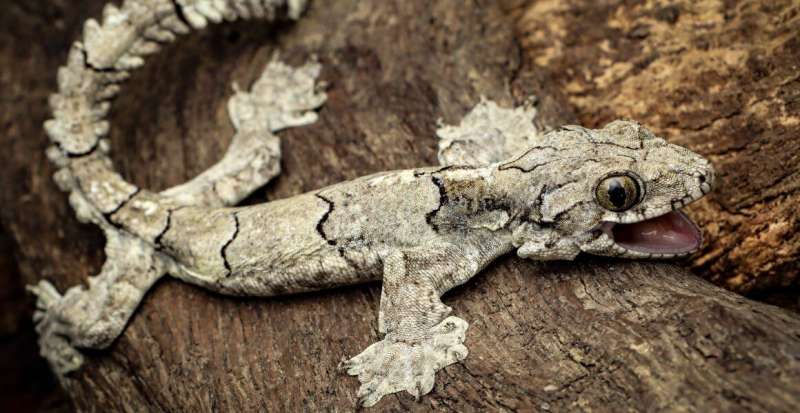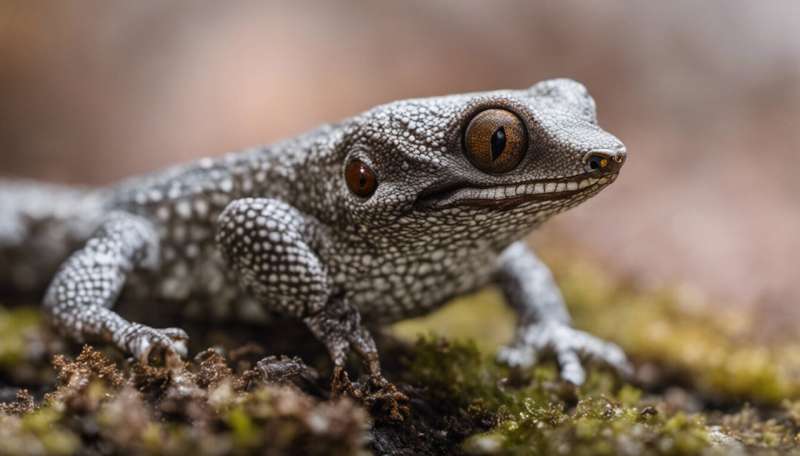This article has been reviewed according to Science X's editorial process and policies. Editors have highlighted the following attributes while ensuring the content's credibility:
fact-checked
trusted source
proofread
New flying gecko species reveals hidden biodiversity of northern India

A new species of gliding gecko has been uncovered in northern India. Bearing the name of the Indian state it was discovered in, the Mizoram parachute gecko, or Gekko mizoramensis, is one of 14 geckos known to take to the air. While one specimen of the new species was collected more than 20 years ago, the differences from its relatives have only now been appreciated.
The researchers behind the study, now published in the journal Salamandra, hope that the new species will highlight the underappreciated biodiversity of northern India and encourage greater efforts to document its wildlife.
Ph.D. student Zeeshan Mirza, who co-authored the paper describing the new species, says, "The wildlife of northeast India isn't as well known as it could be because of the amount of dense forest. While recent development has opened up access, forest clearance endangers its biodiversity.
"Most research in the past has focused on charismatic fauna such as birds and mammals, leaving reptile species underexplored. My own surveys of the region have uncovered several new species, including Salazar's pit viper, which is named after a character from Harry Potter.
"With additional fieldwork, I am confident that more new reptile species will be discovered in the region."
What's so special about geckos?
Geckos are one of the oldest reptile groups still alive today. They are believed to be among the earliest evolving squamates, the group that contains all lizards, snakes and their close relatives, with their ancestors first appearing in the fossil record hundreds of millions of years ago.
In fact, early geckos had already developed some of their key characteristics by 100 million years ago. Genetic studies and preserved remains reveal that they had evolved the adhesive pads on their feet which allow them to climb almost any surface using a network of microscopic hairs.
Other adaptations, such as the ability to discard and regrow their tails to distract predators, or see well in the dark, have helped them to become one of the most successful lizard groups. There are more than 1,200 species of gecko today, making up around a fifth of all known lizards.

Flying geckos are an even more specialized bunch. Originally classed in their own group, they've recently been recognized as a very specialized part of the Gekko genus which evolved at the same time as a group of rainforest trees known as the dipterocarps.
Unlike other gliding reptiles, which use bone to form their flying surfaces, these geckos have flaps of skin. When the lizards leap off a tall structure, air resistance pushes the flaps out to their full extent much like a parachute, slowing the speed at which they fall.
Along with their webbed feet and flattened tail, this allows the geckos to steer while traveling in the air and land safely at their target. The skin flaps also help to break up their shape, acting as a camouflage against predators.
Their specialized camouflage and body shape is shared by multiple species, making it hard to tell them apart from one another. Researchers only discovered that G. mizoramensis was its own species based on genetic analysis, as well as slight differences in size and coloration.
It's thought that the species evolved as a result of being separated from its closest relative, G. popaensis, by the Arakan Mountains. This region is known to be home to numerous species of lizard, with the researchers suggesting that many more geckos may be found not just in India, but also in areas bordering Bangladesh and Myanmar.
The team recommend that more research on the species of this area is done to help find out how many more species of gecko are hiding in the tropical forests.
More information: Paper: A new species of Parachute Gecko of the subgenus Ptychozoon (Sauria: Gekkonidae: Gekko) from the Indo-Burma region
Provided by Natural History Museum
This story is republished courtesy of Natural History Museum. Read the original story here.


















